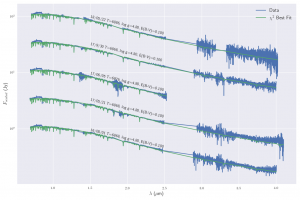Student: Miles Lucas, Undergraduate Student in Physics, Iowa State University
Research Mentor: Dr. Massimo Marengo
The Study of Stellar Debris Disks and Interstellar Medium
I am working on a project on planetary system astronomy under the supervision of Dr. Massimo Marengo at Iowa State University. He is involved with NASA’s Near Infrared Disk Survey (NIRDS) which is a long-running program actively searching for circumstellar debris disks which has been awarded observing time over several cycles. Debris disks are a collection of rocky particles and gas orbiting in the plane of planetary systems. Debris disks provide insight into asteroid belt analogs and information on the system’s physics and dynamics, including planet formation. In order to detect these structures, we model the photospheric emission and corresponding attenuation due to the interstellar medium between us and the stars.

We use data from the SpeX instrument at NASA’s Infrared Telescope Facility (IRTF). This instrument provides the spectral energy distributions (SED) for these systems. We can look at these SEDs for excess in the near-infrared (NIR) which is characteristic of debris emission. In order to do this, a photospheric model is fit in addition to a model for the debris, usually a black body. To accomplish this, I have developed an open-source python package that utilizes the Feldman-Cousins statistical method. We want to use this method to fit the 90+ acquired spectra from IRTF data. This includes the infamous Tabby’s star (KIC 8462852) which has a debris disk that greatly obscures the star. This obfuscation is not well understood by astronomers, yet, so information on its debris disk is of great scientific importance.